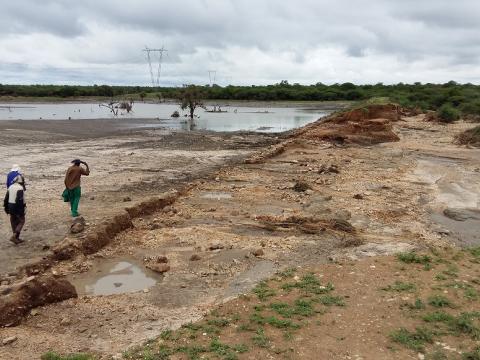Heavy rains and floods in Zimbabwe destroy dams and irrigation infrastructure; likely to impact 2 million people

Bulawayo, Zimbabwe - After suffering a severe El Nino-induced drought which left over 4.4 million people in need of emergency food assistance, the start of the new year is getting above normal rains with floods being experienced in several parts of the country. Floods have, in the past 30 days, hit almost all the 10 provinces of Zimbabwe creating fears of extensive overflows as the water table in most parts of the country is rising and smaller dams are beginning to overspill.
Following the incessant rains in the Mangwe district of the Matabeleland South Province, floods hit a thriving Makwakwa Irrigation Project supported by World Vision, damaging infrastructure worth around US$25,000. The cause of the flooding was due to the heavy down pour of rains and the burst of upstream Matopiya dam, which feeds downstream Makwakwa Dam. The latter could not handle the pressure of a double flow of water from the burst dam and the heavy rains.
Matopiya dam is 5km upstream. The collapse of the Makwakwa dam wall, only 20m away from the irrigation site caused flooding to two and a half hectares of the five hectare cropped area leaving a serious trail of destruction, affecting close to 2,000 beneficiaries. “We are tirelessly working with various partners to respond to the emergency that hit one of the long established projects we have supported over the years. Rain induced emergencies, of late, have affected several parts of the country leaving many in dire need of urgent assistance. Unfortunately our Sanzukwi program is one of the hardest hit”, says Sanzukwi Area Programme Manager, Nqobani Ncube.
The average rainfall received during the past two years was 344 mm. However, midway to the new year the Mangwe district has already recorded an average of 400mm of rainfall. The damage caused by the floods has been enormous with 80m of the Makwakwa dam wall washed away and the remaining 400m extensively developing escarpments.
Maize, sweet potato vines, sugar beans and sorghum grown on an area of two and half hectares all vanished, silting the project area, washing away loose soils, leaving behind aggregate stones and water logging zones. Irrigation canals into the plots have been erased and the 500m diamond fence razed and rolled into a piece of useless wire. The engine house also collapsed, with the weather box washed away and borehole overfilling suspected to have silted too.
“The community is in a state of despair. This appears to us as a dream. We have sleepless nights. Our livestock will die, as we do not have any water source close by for animal drinking. We cannot go back to taking them to Kezi river which is 15km away”, says a dejected member of the Local Management Committee, Mr Phuthi.
The irrigation scheme, established by World Vision in 2002, is a community empowerment initiative following the successful construction of the Makwakwa Dam in 2000 to support livestock and crop production in a bid to ensure household food and nutrition security. The community is already recovering the damaged fence to protect the remaining two and a half hectares of crops. They have speedily adopted bush fencing to cover the damaged area and are contributing funds to purchase barbed wire for fencing.
Makwakwa Irrigation Project has been a source of agricultural produce for the dry Mayobodo and Brunerberg communities. Proceeds from the project have also been channeled towards supporting educational requirements of children in the communities. “The irrigation project feeds communities in Mangwe, with our families and children supported by income raised from the same project", added Phuthi.
World Vision is working on the emergency and called for local stakeholders to join to ease suffering and losses. The Red Cross Society of Zimbabwe said the current floods have claimed 10 lives in Mashonaland West province and 1 six year old girl in Manicaland Province. In Gokwe of the Midlands province, 19 houses collapsed with many more in danger. In the Chipinge district of the Manicaland province, heavy storms continued to pound the catchment area of the great Save River and backflows into the tributaries are being realised.
Flooding threat is increasing in the settlement areas with the Tongogara refugee camp, which houses over 9000 refugees, more likely to be affected given its proximity to the Save River bank. In the Chiredzi district of Masvingo province, 32 houses in the Malipati area have been damaged. In most urban areas, families displaced by flooding are being evacuated from affected swamped dwelling areas and provided with emergency shelter especially those with houses built close to rivers and poorly drained areas.
Meanwhile, Zimbabwe’s Meteorological Services Department has warned that more rains are likely to fall this season throughout the country at a time emergency response stocks are at the lowest and the capacity to deal with floods is minimal. The Civil Protection Unit (CPU), a government agency tasked with maintaining a disaster risk management system in line with international best practices, is advising affected communities to find shelter on higher ground warning that roofs could be blown off and low-cost and mud-built houses risk collapse from water saturation.
CPU says 4% of the country’s population, or around an estimated 2 million, is exposed to extreme flood hazards.



